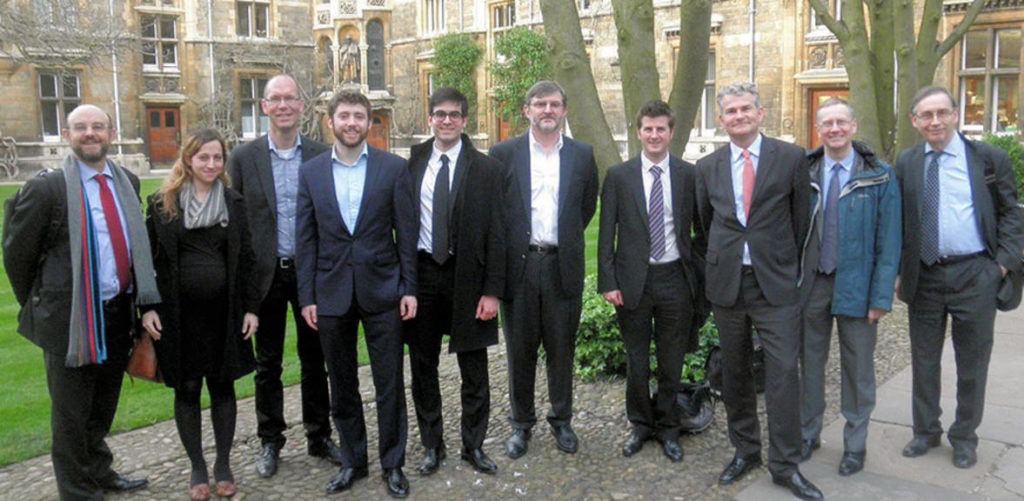As part of our research on Resilient International Supply Chains, we sought to define and prioritise what a research agenda should be over the next two to three years to improve the application of network analytics and systemic shock to helping with decision support for supply chain risk management, risk transfer and insurance quantification.
Improving the insurance market for supply chain risk
During our work on business networks and supply chain risk, we have heard a wide range of opinions about the insurance market for supply chain disruption risk. This appears to be a nascent market that could potentially benefit from better understanding, tools, data, and methodologies for assessing risk. Academic institutions are one potential source of improved understanding of the risk, so to better guide the application of research resources we are conducting this review to prioritise our research agenda.
The available literature and the practitioner views we have heard, suggest that there are several communities of stakeholder interests in supply chain risk:
- Corporate risk managers and potential purchasers of supply chain insurance
Surveys suggest that they would like to obtain more insurance cover to enhance their range of risk management options, but tend to believe that the current insurance products that are offered are poorly matched to their needs. - Insurance providers
Insurance companies recognise the opportunity and believe that they would like a larger market to be created but are concerned that the risk is difficult to quantify, underwrite, diversify, and manage their accumulations to provide the coverage safely. - Other risk management professionals
Intermediaries, brokers, data providers, and consultants have expertise that can influence the market development.
This leading opinion survey and related workshop is attempting to bring all these views together in understanding barriers to the improvement of the market for supply chain insurance, and propose ways forward to overcome them.
Survey of leading opinions
We are soliciting opinions from thought leaders and practitioners on what should be the priorities of research for academics involved in this field, and ultimately to identify where the research activities of the Cambridge Centre for Risk Studies might potentially best contribute, in order to assist risk management professionals, insurers, and other practitioners managing the risk of supply chain disruption in business activities.
Wednesday 9 April 2014
|
Time |
Session |
|---|---|
|
12:30-14:00 |
Registration & Opening Lunch |
|
14:00-15:00 |
Supply chain risk management perspectives
|
|
15:00-16:00 |
Briefings on supply chain topics
|
|
16:00-16:30 |
Coffee break |
|
16:30-17:15 |
Discussion: Bridging the gap |
|
17:15-18:00 |
Recommendations for research agenda |
|
19:00-19:30 |
Pre-dinner Drinks, The Green Room, Gonville & Caius College, Cambridge |
|
19:30-22:00 |
Dinner, The Fellows’ Dining Room, Gonville & Caius College, Cambridge |
Supply Chain Meeting Mind Map
Michel Abbink
Partner, Actuarial & Insurance Management, PwC
Michel Abbink is an actuarial partner at PwC. He joined in 2010 from Swiss Re and has 20 years’ experience in the insurance and reinsurance industry across Europe. His recent work with insurance clients includes projects to improve operating results through operational and technical excellence. Michel is a member of the Data Analytics leadership team at PwC and has been working on the application of data driven tools and solutions to long standing business problems, including the quantification and insurability of supply chain and wider business interuption risk.
A taxonomy of supply chain risks, tools to map and monitor exposures and provide early warning of disruptions, robust modelling techniques to quantify risks in the taxonomy, provide single supplier risk ratings and allow risk/reward trade off in procurement decisions.
Dr Nitin Bakshi
Assistant Professor, Management Science and Operations Department, London Business School
Nitin’s research focuses on management of disruption risk in operations and supply-chain management. In the past, he has studied how to induce supply-chain partners to co-operate and invest efficiently in building a resilient supply chain. He has also studied issues relevant to securing the maritime supply-chain, which faces the risk of terrorist attacks. He has authored papers that look at the economics of the use of container-inspection technology at domestic ports in the US, and also at international ports.
Nitin has also investigated the role of performance contracting in after-sales service supply chains, e.g. for aircraft engines which experience “low probability-high consequence” instances of unscheduled maintenance. Ongoing research work includes the use of incentives to induce supplier effort for improving reliability, and the study of cascading disruptions in interdependent supply chain networks.
Nitin holds a PhD in Applied Economics from the Wharton School, University of Pennsylvania, an MS in Management Science from Stanford University, and a BTech in Electrical Engineering from IIT Bombay. In the past Nitin has also worked as a manager for Hindustan Unilever and as an Algorithms Design Engineer for SmartOps.
Highest priorities:
- Characterising the vulnerability to disruptions of complex supply chain networks.
- Designing and pricing contingent business interruption insurance.
- How to tackle the managerial challenges associated with lack of sufficient data when dealing with “low probability-high consequence” events.
Nick Beecroft
Manager, Emerging Risks & Research, Lloyd’s
Nick Beecroft joined Lloyd’s in 2014 as Emerging Risks & Research manager. The Lloyd’s Emerging Risks team works with external partners to identify and assess risks which are characterised by high uncertainty and the potential for systemic impact. Before joining Lloyd’s Nick worked as a project manager at Catlin, and also completed 12 years as an Intelligence Officer in the Royal Air Force. He is currently studying for an MSc in International Security & Global Governance.
Highest priorities:
- Uncertainty in supply chains: dependencies, critical nodes and measures of effect at the systemic level.
- Quantifying (pricing) supply chain risk: taxonomy of threats and economic impact of disruption at all points in the chain.
- Situational awareness: monitoring/identifying changing risk factors in complex supply chains.
Andrew Bradley
Head of Group Risk Services, Group Risk Service / Nestec Ltd.
Andrew Bradley is the Head of Group Risk Services (GRS) for the Nestlé Group based in Vevey, Switzerland and an ACII. Prior to joining Nestlé, Andrew worked with Legal and General Insurance Company and Sedgwick Forbes in the United Kingdom.
As part of Nestlé’s risk financing strategy he has introduced centrally driven global insurance programmes, as well as developing the Group’s captive reinsurance company, Intercona Re, of which Mr Bradley is the CEO. The captive has been used not only as a risk financing tool but also as a strategic tool to drive both loss prevention and risk identification. In addition GRS has developed an Enterprise Risk Management and Business Continuity Management Concept for the Nestlé Group.
Another “passion” is safe driving which the GRS team has promoted within the Nestlé Group, using the captive to help introduce web-based driver training tools and, in some countries, telematics, as well as establishing a “tool kit” to assist Nestlé operations around the world.
Andrew is a member of the M200, the Industry Insurance Panel and currently Vice Chairman of the Global Road Safety Partnership (GRSP).
Insurance and Supply Chain
Dr Alexandra Brintrup
Lecturer in Manufacturing Informatics, Cranfield University
Dr Alexandra Brintrup is a Lecturer in Manufacturing Informatics at Cranfield University and a Visiting Lecturer at the University of Cambridge. After her PhD in Operations, she carried out her postdoctoral work at the Institute for Manufacturing at Cambridge, and then worked as a fellow at the CABDyN Complexity Group at the University of Oxford. Dr Brintrup’s research examines complexity in manufacturing and supply networks. She is particularly interested in the impact of structure on the robustness and performance of organisational ecosystems. She uses both empirical and analytical modelling, as well as computational modelling to analyse fundamental patterns in complex networks and develops intelligent systems to navigate through complexity. She also applies computational intelligence techniques to aid practical problems that are a result of complexity. She teaches Decision Engineering, Operations Management and Supply Chain Management.
Highest priorities:
- Developing empirically backed understanding of emergence in large-scale supply networks.
- Harnessing big data analytics in supply networks for quantitative risk analysis.
- Understanding systemic, inter-industry risk.
Neil Campbell
Director, EPIC Risk Solutions
Neil is an independent risk consultant working mostly in the life science and chemical sectors. With a background as risk manager of Zeneca and AstraZeneca and more recently as Global Head of Life Sciences at London-based insurance broker Jardine Lloyd Thompson, Neil has been involved in supply chain risk analysis and supply chain risk financing for over 20 years.
Neil leads a small team that has developed a new insurance solution specifically for the life science sector, which has been successfully commercialised by Munich Re and which provides clients with a much broader protection than has been previously available, focused as it is on understanding the financial consequences of regulatory non-compliance in the manufacturing process.
Neil has an MA from the University of Cambridge in Applied Biology and is ACII-qualified.
Professor Martin Christopher
Emeritus Professor of Marketing and Logistics, Cranfield School of Management, Cranfield University
Martin’s work in the field of logistics and supply chain management has gained international recognition. He has published widely, his recent books including Logistics and Supply Chain Management and Marketing Logistics. Martin co-founded the International Journal of Logistics Management and was its joint editor for 18 years. He is a regular contributor to conferences and workshops around the world.
Highest priorities:
- The development of tools to enable supply chain risk to be identified and measured.
- Developing strategies for supply chain risk mitigation.
- Understanding the impact of product design decisions on supply chain risk.
Supply Chain Risk Research: Past, Present and Future
Dr Andrew Coburn
Director of External Advisory Board, Centre for Risk Studies, University of Cambridge
Andrew Coburn is one of the organisers of the workshop and an active participant in the research programme on Resilient International Supply Chains at Cambridge Centre for Risk Studies. Andrew is helping to lead the ‘System Shock’ research into catastrophic failure of interconnected networks, and has many years of experience in insurance risk management. He is one of the leading contributors to the creation of the class of catastrophe models that over the past 20 years has come to be an accepted part both of business management in financial services and of public policy making for societal risk. He has extensive experience in developing models and using them for business decision support. Dr Andrew Coburn is a member of the senior management of Risk Management Solutions, the leading provider of catastrophe risk models to the insurance industry.
As a risk modeller, and from my experience in the insurance world in developing catastrophe models at Risk Management Solutions, I have seen several examples of how an independent risk model can assist with the development of a risk transfer market. My expectation is that the risk transfer market for supply chain disruption could be greatly enhanced if an authoritative and transparent model could be developed. I am interested in the state of the art of supply chain modelling and what advances would be needed for a full risk management-enabled model of supply chain risk to be accepted by both the insurers and the corporate risk managers.
Highest priorities:
- A model to quantify disruption risk in a company-specific supply chain network, incorporating the tail risk of extreme catastrophic scenarios of correlated or regional impact, as well as site-specific and operational risks of failure of individual suppliers, sites, or transportation linkages.
- Simplified data capture requirements to enable first-order risk assessment to be made without having to obtain detailed data on thousands of supply nodes in the supply chain – possibly using representative configurations of typical commercial sectors as a starting point.
- Development of a good representation of macroeconomic value flows from supply chains internationally as a understanding of the importance of these supply chains to the global economy.
Martin Dockrill
Associate, Financiers Due Diligence, JLT Speciality
Martin presently works for the Due Diligence Team at Jardine Lloyd Thompson in London, where he helps financial institutions assess their risk exposures on major construction projects. His insurance career began at the then UK’s largest composite insurer before leaving to take an MBA at Manchester Business School where his thesis concerned the underwriting of risk using artificial intelligence. At Aon in London, his responsibilities included being a manager in their Major Accounts and Projects units where he developed a strong grounding in some of the more esoteric fields of insurance for larger corporations, e.g. catastrophe cover, mortality, EIL and business operations.
He is a Senior Examiner for the Chartered Insurance institute (“CII”) and has contributed to a recent report by the UNEP Chemicals Branch as well as various textbooks such as “Market Failure and Climate Change” in the CII’s book Coping with Climate Change: Risks and Opportunities for Insurers and President Clinton’s Y2K Committee in 1999. His work on pandemics, “Pandemic Influenza: Managing the Risks of an Invisible Threat” and “Pandemic Influenza: Exploding the Myths”, were highlighted in a number of projects by authorities in the United States, Canada and South Africa.
Perhaps a practical issue for the research to consider sooner rather than later would be the limitations of the basic contingent cover contractors arrange for themselves and their financiers on major projects. These limitations invariably arise because the parties involved rarely have the time to meet tender deadlines to assess the supply risk beyond a simple risk assessment which, as the advances this research shows, is rarely adequate anyway. Accordingly:
- Insurers only offer contingent cover for loss of profit following damage to any supplier in the supply chain for a nominal amount (£1m or £2m) but will increase it slightly for named Tier 1 suppliers, neither of which meets the risk exposure. Given the same supply exposures common to many construction projects, could the work on supply clusters be used to give insurers enough confidence to not only extend DSU cover to include lower tiers and/or increase the contingent amount to a practical level say a percentage of contract price?
- The cover provided is only for damage to suppliers by FLEXA perils, i.e. fire, lightening, earthquake, explosion and aircraft. Could the research be linked to advances in geographical location technology to include damage at suppliers by wet perils too, i.e. flood, storm etc.?
Highest priorities:
- Link with capital markets to overcome capacity and contagion issues.
- The tier level at which the supply risk is a practical level for insurers.
- The extent of cover insurers can comfortably offer at various tier levels.
Stephen Gibson
Senior Catastrophe Analyst, Hiscox Underwriting
Stephen joined Hiscox in 2009 and works within the London Market Property and Terrorism Divisions (Lloyds Syndicate 33). He is currently responsible for the company’s ‘Big Ticket’ property modelling for exposures domiciled both in North America and internationally, as well as Hiscox’s worldwide terrorism portfolio.
For Hiscox, catastrophe modelling plays an increasingly important role in both the pricing of individual (client) risks as well as at a group perspective. Hiscox endeavours to calculate its ‘group risk curve’ for various levels of loss and sources of loss (Japanese earthquakes, Florida windstorms, etc.) – how much would Hiscox pay out (on a gross and net basis) in a one in 5,10,20,50,100 or 250 year industry event (event loss to the insurance industry)?
The modelling/pricing Hiscox undertakes concerning a given client risk (on behalf of their underwriters), is solely based upon a given client’s submitted site values (with associated geographic locations). Whilst the quality of this ‘direct exposure’ is high (especially from Hiscox’s North American clients) it is rare that the company receives any detailed information regarding exposed CBI risk. As such, from a modelling standpoint, CBI is not explicitly factored into any of Hiscox’s work.
Internally Hiscox does attempt to quantify, on a line of business basis, the likely relative exposure of CBI from worldwide events. This is a highly subjective process based on the underwriter’s knowledge of each risk and that risks underlying lines of distribution.
Prior to working for Hiscox Stephen graduated with a Masters in Earth Sciences from Oxford University in 2008, after which he spent several months working in exploration mining in northern Quebec.
It is extremely desirable to be able to define, by industry type and country of exposure, the regional spread/proportion of the subsequent supply chain, e.g. what proportion of South Korean clothing suppliers’ goods are distributed to USA, Canada, Western EU, Japan, etc.?
And then within these countries that are supplied, what proportion of their supplies come from a given source country, e.g. what percentage of a clothing retailer in North America’s goods come from the USA, Canada, the Western EU, Japan, etc.?
Highest priorities:
- Most susceptible countries of supply, by industry type and the countries these products are distributed supply to.
- Where are the show stoppers in the supply chain for a given industry? Which worldwide products have a very narrow supply chain, e.g. car parts only built on an industrial estate in China but used on a worldwide basis?
- What events regionally are the biggest threat to a given supply chain – flooding and typhoons in South Korea, government funding cuts in Poland, civil commotion/strike in Thailand, etc. – and what would the lag time be (instantaneous, months due to stock piling, etc.) to the chain?
Dr Dougal Goodman OBE FREng
Chief Executive, The Foundation for Science and Technology
Dr Goodman is Chief Executive of The Foundation for Science and Technology, which facilitates debates between Parliament, Whitehall departments and the business and research communities on policy issues that have an underlying science, engineering, or medical element. Before joining the Foundation he was Deputy Director of the British Antarctic Survey, a General Manager for BP and a research fellow at the Cavendish Laboratory at the University of Cambridge.
Dr Goodman does consulting work for the insurance industry, particularly in the marine market, and chairs the Lighthill Risk Network – a consortium of companies working to build stronger links between the insurance market and the research sector.
With a background in policy and strategy development in the oil and gas, shipping and government-funded research sectors, Dr Goodman has also managed large logistic and engineering operations – at BP the Magnus Oil Field, operations of two ships and five aircraft at the British Antarctic Survey and small polar expeditions.
Dr Goodman has a special interest in the application of extreme statistical analysis methods to financial, insurance, shipping and oil field operations.
Economic and system analysis to optimise resource allocation under constraints to maximise a well-defined resilience function for specific supply chains.
Olivier Hautefeuille
CEO, SCOR UK, and Chief Underwriting Officer, SCOR Global P&C
Civil engineer Olivier Hautefeuille started his career as a site engineer on a nuclear plant in France and then moved to Saudi Arabia. He joined the insurance industry in 1991 as construction underwriter for SCOR.
Besides Paris he has worked in several major insurance hubs, such as London and Hong Kong. His experiences include not only reinsurance but also insurance in various companies. In 2002 Olivier Hautefeuille returned to SCOR as Business Sector Leader of the Contracting and Major Project department.
Until 2012 he was CUO of Industrial and Commercial Risks within Business Solutions, the division of SCOR Global P&C dedicated to large corporate clients.
Since 2012, Olivier Hautefeuille is the CUO of Construction and Specialties, including Captives, and, the CEO of SCOR UK Company. He is based in London.
A modelling of the SCM for a given industry more linked to the processes and management practices, and, also a modelling for accumulation scenario purposes.
The point of view of an underwriter
Paul Hopkin
Technical Director, Airmic
Paul Hopkin is based in London as technical director at Airmic. He was previously Director of Risk Management for The Rank Group, and prior to that Head of Risk Management at the BBC. He started his career in risk management as one of HM Inspector of Factories with the Health and Safety Executive. He has also worked extensively in the insurance industry, including periods as technical director at Sedgwick Risk Control Services and managing director at Fenchurch Risk Management.
He was the project leader of the working group developing ISO 31004, the implementation guide to the international risk management standard, ISO 31000. Until recently, Paul was the lead examiner for the Certificate in Risk Management (CIRM) qualification from the Institute of Risk Management. He is author of Fundamentals of Risk Management, the textbook for the CIRM course, as well as the textbook Strategic Success: Risk Management. He is also joint author of the recently published research report Roads to Resilience.
The extent and circumstances where suppliers are treated as a cost to be controlled, rather than an asset that is part of the ‘relationships and networks’ of the organisation that need to be valued and nurtured – and the means by which this situation can be achieved.
Highest priorities:
- Quantifying and financing supply chain risk exposures.
- Ensuring sound ethics and behaviour in the supply chain.
- Integrating suppliers into the business model to increase resilience.
Marc Jansen
PhD Candidate in Management Studies, Cambridge Judge Business School
Marc is a second year PhD candidate working towards a first paper for publication in a top tier operations management journal. He specialises in applying game theoretical and econometric methods to study disruption risk prevention and mitigation under incomplete information. Recent events have established that major interruptions of front-end service operations are high-profile and costly, with costs increasing relative to the duration, frequency and proximity of outages. Marc’s current work examines how contract choice between an IT vendor and client can mitigate system downtime costs given the allocation of end-to-end responsibilities. To bridge the gap between theory and practice he is in frequent contact with various contacts in the oil and gas, aerospace and defence and insurance industries. As a teaching assistant on both MBA and EMBA, Marc frequently engages in discussion and simulations with students on topics of supply chain risk.
My decision to pursue this PhD followed recognition of various shifts in the procurement landscape and a wish to demonstrate how operations management needs to adapt to these shifts. First, contracting has taken on a strategic function to reveal valuable counterparty information and actively manage risks, although risk cannot be fully eliminated. Second, most risks are unknown or materialise infrequently, necessitating the use of complex and incomplete contracts. Complex contracts are unfavourable as a result of design, monitoring, and enforcement costs. Third, timing and cost pressures in the supply chain have forced the removal of any slack in the system, which can greatly exacerbate the cost of disruptions if they do materialise. Finally, exposure to supply risks has become exceedingly hard to identify and single out as manufacturers have come to rely on a dynamic portfolio of outsourcing partners both on- and off-shore.
Highest priorities:
In short, I see three priority objectives for future research in SCRM:
- Improved understanding of industry specific business interruption incidence and evolution as well as long term damage.
- Mapping implementable contracts to the risks they can alleviate.
- Examining the use and availability of supply risk intelligence in decentralised systems.
Claes Mårtenson
MD and Founder of RISC (Risk & Insurance Strategy Consulting)
Claes has developed over a 27-year career into one of the few true Enterprise Risk Managers in Europe. He started his risk management carrier in 1987 with FM Global. He successfully introduced systematic risk management as Corporate Risk Manager for Ericsson (telecom systems), GKN (automotive and aerospace) and Solvay (chemicals and pharmaceuticals).
He has a Chemical Engineering degree from Stockholm, Sweden and Sydney, Australia.
Claes has lived and worked in Sweden, Australia, Norway, the UK, Canada and Belgium and he speaks five languages.
RISC is specialising in advising insurance companies on strategy, product development and relationship management.
Markus Mende
Group Managing Director AGRC EMEA, Aon Risk Solutions
Markus Mende is responsible for Aon’s Risk Consulting Services in EMEA based out of Basel, Switzerland. He joined Aon in 2000 from Allianz where he designed global funding solutions for employee benefits as a Regional Director in London. In his current role, Markus focuses on supporting large global corporate clients develop their insurance operations to a best practice standard from a governance, finance, risk management and mitigation as well as process perspective.
Markus provides thought leadership:
- as a Chairman of Aon’s Risk Consulting Board EMEA
- as a member of AGRC’s Global Board
- as a member of Aon’s Solvency II Steering Committee
- as a director of Aon Benfield driving Aon’s effort to develop its reinsurance advisory capability in EMEA
Markus graduated from the London School of Economics with a Bachelor in Economics and obtained a Masters in Economics from the University of Oxford. He completed his studies with a PhD in Economics and Statistical Methods at the University of Dresden, Germany. Markus is a German national and married. He spends a good part of his spare time with his three children exploring Switzerland’s great outdoors.
Professor Nektarios (Aris) Oraiopoulos
Professor of Operations and Technology Management, University of Cambridge Judge Business School
Nektarios (Aris) Oraiopoulos is a Professor of Operations and Technology Management, University of Cambridge Judge Business School at Cambridge Judge Business School, University of Cambridge. His research interests lie in the area of collaborative product development and supply chain risk management. Aris is particularly interested in the design of contractual mechanisms (formal and informal) that improve efficiency and resilience in complex systems. He received his PhD in Operations Management from the Georgia Institute of Technology, and a Diploma in ECE from the National Technical University of Athens. His work has been published in the journals Management Science, and Production and Operations Management.
Highest priorities:
- Role of partnerships/collaborations as risk mitigation methods.
- Informal mechanisms that improve collaboration between the supply chain tiers.
- Determinants of risk attitudes across the supply chain
Dr Alan Punter
Associate of the Centre for Risk Studies, University of Cambridge
Alan has spent 25 years in the insurance industry with international broking groups Sedgwick, Alexander & Alexander and Aon, in a variety of risk analysis, risk consultancy and risk financing roles. He was also CEO of Aon Capital Markets Limited, until his retirement from Aon in 2008.
Alan has written widely in the professional trade press and spoken at over a hundred international conferences on risk management and risk financing issues. He was awarded the inaugural Lumina Award for outstanding research in reinsurance in 2001, wrote the Institute of Financial Services text book on “Risk Financing and Management”, and was co-author of the 2011 Airmic report “Roads to Ruin: A Study of Major Risk Events, their Origins, Impact and Implications”, a detailed case study review of 18 corporate crises. In 2013 he completed a further case study-based report for Airmic entitled Supply Chain Failures.
His main activities now include being a Visiting Professor at the Cass Business School, City University, where he lectures on the MSc in Insurance and Risk Management programme, and as an Associate of the Cambridge Centre for Risk Studies.
Alan holds a BTech degree in Mathematics, an MSc in Statistics, a PhD in Operations Research and an MBA in Finance (with distinction). He also obtained the Associate in Risk Management and Associate in Reinsurance qualifications from the Insurance Institute of America.
Conventional insurance is rather hidebound by the strictures of “named perils”, “insurable interest”, and “indemnity”. By definition any one company’s supply chain risk encompasses multiple perils, impacting a dynamic network of entities outside of that company’s ownership, and the estimation of any consequential losses is very difficult (may involve perceived moral hazards and many “what ifs”).
Highest priorities:
- Contract structure: is it possible to define a contract under these circumstances that is effective and qualifies as insurance?
- Supply: given an appropriate contract structure, are insurers able to write supply chain risk coverage at attractive price, allowing for the uncertainties of multiple events and their potential aggregation and bearing in mind the need to earmark adequate capital (for prudential solvency and rating agency purposes)?
- Demand: given an appropriate contract structure with a risk-weighted premium, is there a real demand from clients for risk financing/transfer – or is supply chain risk regarded as a business operational risk that just has to be managed and absorbed as well as possible?
Professor Daniel Ralph
Director of the Centre for Risk Studies, University of Cambridge Judge Business School
Daniel Ralph is the principal investigator of the Resilient International Supply Chain research programme at the Centre for Risk Studies, and the convenor of the workshop. He is Professor of Operations Research and a founder and Academic Director of the Centre for Risk Studies at the University of Cambridge Judge Business School. He is also a Fellow and Director of Studies at Churchill College. Prior to joining Cambridge for a dual appointment in the Engineering Department and the Business School, Daniel held academic positions at Cornell University and the University of Melbourne. His research interests include risk in business decision making and investment under risk for energy companies, underpinned by optimisation methods and theory. He is joint Editor-in-Chief of the journal Mathematical Programming.
Rhys Thomas
Property Senior Class Underwriter, Catlin
Rhys Thomas joined Wellington Syndicate 2020 at Lloyd’s in 2002 after graduating from Manchester University with a degree in Economics and Modern History. After the purchase of Wellington by Catlin in 2006, Rhys was promoted to Class Underwriter within the Direct Property Team. In 2013 Rhys was promoted to Senior Class Underwriter for the North American Property Group with responsibility for all direct and facultative business written out of the London platform.
The 2011 Japanese earthquake and tsunami caused significant disruption to the supply chain of a number of global manufacturing operations. The floods in Thailand later that year exacerbated the situation. The two events combined created a large number of Contingent Business Interruption and Contingent Extra Expense (together classified as Contingent Time Element (CTE) exposures) claims from sources that we identified and expected, but these events also created the potential for claims from unidentified (either by the original businesses affected or by insurers) sources and this has undoubtedly heightened Underwriters awareness of the need to focus upon the exposures being assumed under these heads of covers. As with any major loss there are lessons that can be learned by clients and Underwriters alike. These include:
- Industry specific “bottlenecks”.
- How do insurance companies keep pace with technological advancements?
- How does aggressive capital impact market discipline effect Underwriting terms and conditions in the current market?
- Accurately scheduling revenue streams from direct and indirect customers and suppliers.
- Can CBI claims be accurately adjusted?
- Which legal systems are developed enough to give certainty to insurance policy coverage?
Christian Wegner
Senior Corporate Underwriter, Corporate Underwriting, Munich Re
Christian Wegner has worked for Munich Re since 1997, and as a property treaty underwriter for around 10 years. Since 2008 he has been in the Corporate Underwriting Property department, responsible among other things for knowledge management, trainings, underwriting guidelines and different projects. In 2012 and 2013 he became leader of Munich Re’s CBI project, with ongoing responsibility for this topic.
Highest priorities:
- Better identification of possible weak points in the production processes, as well as critical relationships with suppliers and subsequent effective loss prevention/mitigation measures.
- Better methodologies to translate the above knowledge into figures to be able to quantify the supply chain interruption exposure and to control the accumulation potential.
- Methodology for identifying/quantifying the “Aggregated Maximum Receiver’s disruption effects” caused by single event failures within the supply chain.
Dickie Whitaker
Director, Lighthill Risk Network
Dickie Whitaker is Director of the Lighthill Risk Network. He has held board positions in analytical, broking and consulting services in London and New York with Guy Carpenter. He left in 2010 to focus on activities with both the Lighthill Risk Network and Financial Services KTN. In 2011 Dickie was one of the founders and Director of Oasis Loss Modelling Framework, a not-for-profit catastrophe modelling platform.
We need an approach that can allow for the insurance sector to understand the fragility and allow differentiation by industry segment. This probably means that we need a way to categorise the susceptibility of industries to supply chain risk. Ideally we will need a framework that will allow others to include their data so all will benefit. And to do all that we need to have a view on the best approach to dealing with all of this.
Highest priorities:
- Develop a high-level framework.
- Classify industry supply risk characteristics by segment.
Nick Wildgoose
Global Supply Chain Product Leader at Zurich Insurance Group, Zurich Financial Services
Nick Wildgoose is a qualified accountant and supply chain professional who has worked in a number of industry sectors. He has served as a non-executive director of the Chartered Institute of Purchasing and Supply, the largest professional supply chain body in the world. Nick has also worked with the World Economic Forum on helping to address the critical issue of systemic supply chain risk.
His particular interests currently revolve around the area of supply chain risk and applying technology to improve supply chains.
Other Contributors
Jonathan Clark
Head of Business Solutions & Syndicate Claims Management, SCOR Global P&C and President, London Business Interruption Association
Jonathan joined SCOR in January 2013 to head SCOR’s London-based Business Solutions claims team and to be responsible for the Claims Management of the Channel Syndicate.
Jonathan has been a claims professional for over 30 years and has held international executive positions with Crawford and Cunningham. He was claims director at the Financial Services Compensation Scheme from 2007 to 2009.
As a practicing loss adjuster his professional work has focussed on financial losses particularly those arising from contractual liabilities in manufacturing industries. He has dealt with claims in over 40 countries and also lectured on the investigation and management of business interruption and product liability claims particularly in industrial processing, life sciences and chemical industries.
Jonathan is a graduate in biochemistry and biochemical engineering from Oxford and London Universities. A Chartered Loss Adjuster and Chartered Insurer, he is a past Chair of the Faculty of Claims and current President of the London Business Interruption Association.
Catherine Geyman
Director, Intersys
Mrs Geyman is an experienced supply chain risk management consultant, having worked most of her career either in-house for a large pharmaceutical company or as an outside resource to a number of firms. She is a founding Director of InterSys Risk, which is part of InterSys, a UK-based risk management and information technology consultancy that specialises in risk modelling, customised risk software and disaster recovery solutions.
Mrs Geyman also designs and develops specialised risk software tools to support enterprise integration of risk management activities, including the award winning supply chain loss estimation and mapping tool, SCAIRTM. She is a Chartered Engineer and a graduate in Electrical Engineering and Pharmaceutical Engineering.
As someone who has researched a range of non-damage interruption incidents in specific industries (mainly life science and food) over the past six years, I believe that the opportunity for the most illuminating research is in industries at the ‘feedstock’ end of our global manufacturing supply chains e.g. the raw materials, basic chemicals and extraction industries. Interruption events affecting manufacturers that supply end products to consumers are easier to track because they make the news in some form or another (e.g. a product recall, a market shortage). Interruption events affecting starting material manufacturers are much harder to track down in the public domain because the market facing end of the supply chains invariably manages to absorb a degree of the impact and much of the time, avoids embarrassing news headlines. So my advice is to spread the net wide (in terms of the type of threat) and focus on industry specific solutions.
Highest priorities:
- Log any interruption event that causes a material shortage in chemicals, mining or agriculture (ok, that’s a big brief!)
- Attempt to quantify the resulting loss in profit for individual operators and the additional costs associated with work-arounds (this is the hardest part)
Christopher Lajtha
Independent risk management resource, ADAGEO
Christopher Lajtha became an independent risk management resource in June 2005. Chris provides support services to multinational companies – with or without in-house risk and insurance management teams – via a small network of experienced and independent risk management professionals.
From 1992-2004, Chris held the position of Corporate Risk & Insurance Manager at Schlumberger. Over the last 35 years, he has travelled extensively and worked out of the UK, the USA and France.
Key areas of focus include enterprise-wide risk management, risk governance and risk management oversight, supply chain risk management, crisis response and multinational insurance management issues.
Chris is a graduate of the University of Manchester (BSc), and the Chartered Insurance Institute (FCII). He trained in the Lloyd’s Market in London before moving into corporate risk and insurance management in 1981. In 1995, he was one of the first risk managers in France to become an Associate in Risk Management (ARM) awarded by the Insurance Institute of America.
Chris writes periodically for the risk and insurance management trade press, facilitates professional forums and training seminars, and make has made presentations at a number of different national association conferences in Europe and North America.
Highest priorities:
- Whether a focus of key value chains might not be more useful than trying to map / analyse multiple supplier tiers? Is so, how can the key value chains be tracked?
- Non-damage triggered business interruption protection – are pre-paid bonds the best solution to dealing with the challenge of accumulations.
- What improvements / alternatives can be imagined to the traditional composite and retrospective “rate of gross profit” applied to anticipated turnover as a measure of indemnifiable loss.
- To what extent can a CBI extension to a BI policy be customised to include perils not covered under the mother policy?
Chris McGloin
Vice President of Risk Management & Insurance, Invensys
Chris joined Invensys in 2006 as their risk manager, where his responsibilities include enterprise risk management, business continuity and insurance.
His initial career was as an underwriter with the Royal Insurance Group before moving into insurance broking and risk management first with Sedgwick and then with Aon. He has worked extensively with captives and is a director of the Invensys captive insurance company.
As this year’s Airmic chairman, he has continued to emphasise the importance of professionalism not only for the risk manager but also for the wider stakeholders in the insurance and risk management community.
He also chairs the insurance steering group for Airmic where a particular focus is the efficacy of insurance products in general and supply chain risks in particular. He has participated in workshops and round table events on these risks.
As risk manager of Invensys he has worked with senior management on a number of different initiatives to address risk assessment and mitigation for the different business interruption exposures. He has also experienced at first hand some of the practical recovery and claims issues following loss of significant suppliers in Japan as a result of the recent earthquake and tsunami.
The insurance marketplace for commercial insureds has been largely devoid of real creativity and innovation for too long. Insurers and intermediaries have been prepared to accept the status quo and compete mainly on price in a static market. There have been some notable attempts to develop creative supply chain covers but these have not had a major impact to date.
New capacity and potential competition from emerging global markets should provide the impetus for European and US insurers to look for new approaches to address supply chain exposures in the digital world.
Highest priorities:
- Developing improved capability to map and share risk information to allow supply chain risks to be understood. Consideration of protocols to address confidentiality and commercial sensitivities.
- Development of a robust database of historic events, and actual losses (insured and uninsured) to allow accurate understanding of known risks and lessons learned / to be learned.
- Development of best practice insurance standards to allow customers to understand the difference between good and bad insurance solutions.
Francesca Romana Medda
Professor in Applied Economics and Finance, University College London (UCL)
Francesca Romana Medda is a Professor in Applied Economics and Finance at the University College London (UCL). From 2010 she is the Director of the UCL QASER (Quantitative and Applied Spatial Economics Research) Laboratory. Since 2012 she has served as economic adviser to the UK Ministry of Environment and Agriculture (Defra) and in 2014 at the Ministry of Finance (Her Majesty’s Treasury). Her research focuses on project finance, financial engineering and risk evaluation in different infrastructure sectors such as: the maritime industry, energy innovation and new technologies, urban investments (smart cities), supply chain provision and optimisation, airport efficiency.
Professor Medda’s work is published in leading academic and practitioner journals. She has been an advisor to the European Investment Bank, the World Bank, UNESCO, UN-Habitat, and UITP. At present she holds several grants, two of which pertain to the application of complexity analysis in the real world. She is Co-Investigator in the £6.2m EPSRC Programme Grant “Liveable Cities” and the £5.8m grant “New Business for Infrastructure Investments”. She is a member of two EU networks of excellence: NEARCTIS and COMPLEXITY-Net under EU FP7. From 2007 she serves on the Executive Board of Directors of a major public transport company in Italy.
The interdependencies of infrastructure and how these interdependencies change and adapt is a major focus of my work. The interactions within the supply chains can determine risks but also opportunities when we consider the investment in the infrastructures that supports the operation of the supply chains. We have been working with agent based modelling and network analysis in order to verify the resilience, risks and anticipatory benefits of investments.
Highest priorities:
- Infrastructures.
- Commodities and resource securities.
- Developing and emerging economies.
Helen Pope
Head of Insurable Risk, Tesco Stores
Helen Hayden joined Tesco as Head of Insurable Risk in 2012 after eight years as the Group Insurance and Risk Manager at Prudential. She has worked for over 20 years in the insurance industry, mainly as an in-house insurance risk management specialist, but spent a short time in an insurance broking role. Ms Hayden is an Associate of the Chartered Insurance Institute and Institute of Risk Management, and the 2nd Deputy Chairman of Airmic. She is leading the initiative on behalf of European insurance and risk managers to simplify the purchase of global insurance.
Professor Yossi Sheffi
Elisha Gray II Professor of Engineering Systems, Center for Transportation & Logistics, Department of Civil and Environmental Engineering, MIT
Dr Yossi Sheffi is a professor at the Massachusetts Institute of Technology, where he serves as Director of the MIT Center for Transportation and Logistics (CTL). He is an expert in systems optimisation, risk analysis and supply chain management, which are the subjects he teaches and researches at MIT.
Highest priorities:
- Developments of risk metrics that will allow companies to determine where to focus their attention along the supply chain.
- The relationships between complexity and supply chain risks.
- The definition of flexibility, including possible metrics.
Highest priorities:
- Developing models that help identify hidden risk in the supply chain.
- Developing methods to reduce risk.
- Developing methods to measure risk.






























